TonyWilliams
Well-known member
On one of the other threads, there are musings as to what is the actual longest distance, and at what speed.
So, I think I found a reasonable test area for a long distance run (from San Diego). On Interstate 8, from the Dunaway Road exit just west of Imperial/Calexico, California, to Gordons Well exit 151, 20 miles west of Imperial/Calexico.
It's exactly 50 miles, right at sea level (so no density altitude issues), and it could be driven at night with low traffic and temperatures much closer to "standard". Also, there won't be much wind at night. The range of elevation starts at under 100 feet, and goes to just below sea level, and then back up to slightly over 100 feet.
But, I'd have to have an auxillary light source (I have that; super bright HID lights from our off road racing bikes) so that I'm not running traction battery power. Also, I'd have to trailer the car there (about 104 miles). I called the Nissan dealer in Imperial, and they had no idea what I was talking about for a LEAF charger. That will be middle America for many years, unfortunately.
Also, my tow vehicle can run as a rear end crash barrier, running the 4 way flashers, and follow the LEAF at 28-ish mph for almost 5 hours !!
I'll have to rent a car carrier, since I don't have one. Any other ideas? I'll definitely film and record SOC numbers, etc.
Tony
So, I think I found a reasonable test area for a long distance run (from San Diego). On Interstate 8, from the Dunaway Road exit just west of Imperial/Calexico, California, to Gordons Well exit 151, 20 miles west of Imperial/Calexico.
It's exactly 50 miles, right at sea level (so no density altitude issues), and it could be driven at night with low traffic and temperatures much closer to "standard". Also, there won't be much wind at night. The range of elevation starts at under 100 feet, and goes to just below sea level, and then back up to slightly over 100 feet.
But, I'd have to have an auxillary light source (I have that; super bright HID lights from our off road racing bikes) so that I'm not running traction battery power. Also, I'd have to trailer the car there (about 104 miles). I called the Nissan dealer in Imperial, and they had no idea what I was talking about for a LEAF charger. That will be middle America for many years, unfortunately.
Also, my tow vehicle can run as a rear end crash barrier, running the 4 way flashers, and follow the LEAF at 28-ish mph for almost 5 hours !!
I'll have to rent a car carrier, since I don't have one. Any other ideas? I'll definitely film and record SOC numbers, etc.
Tony




